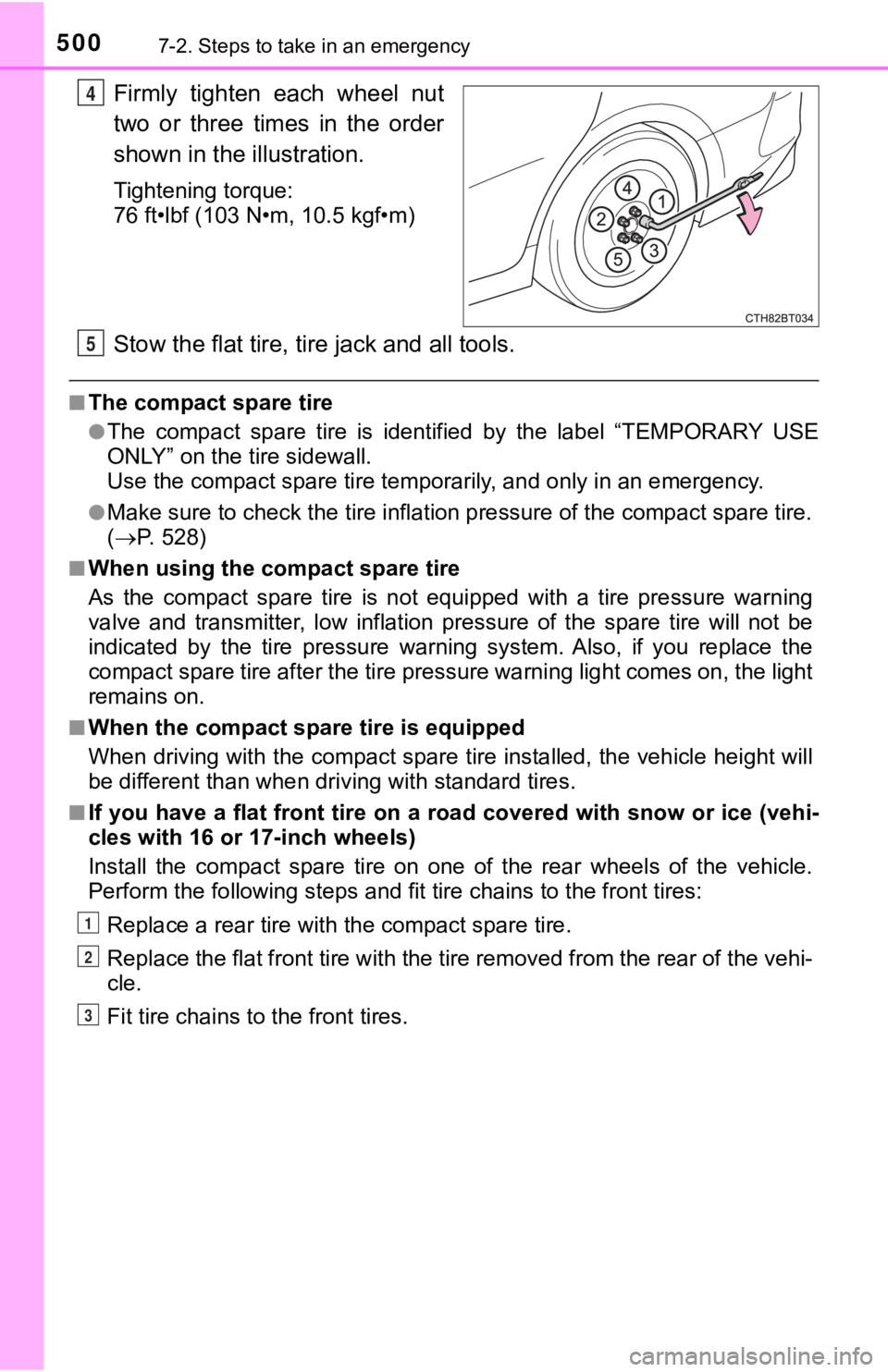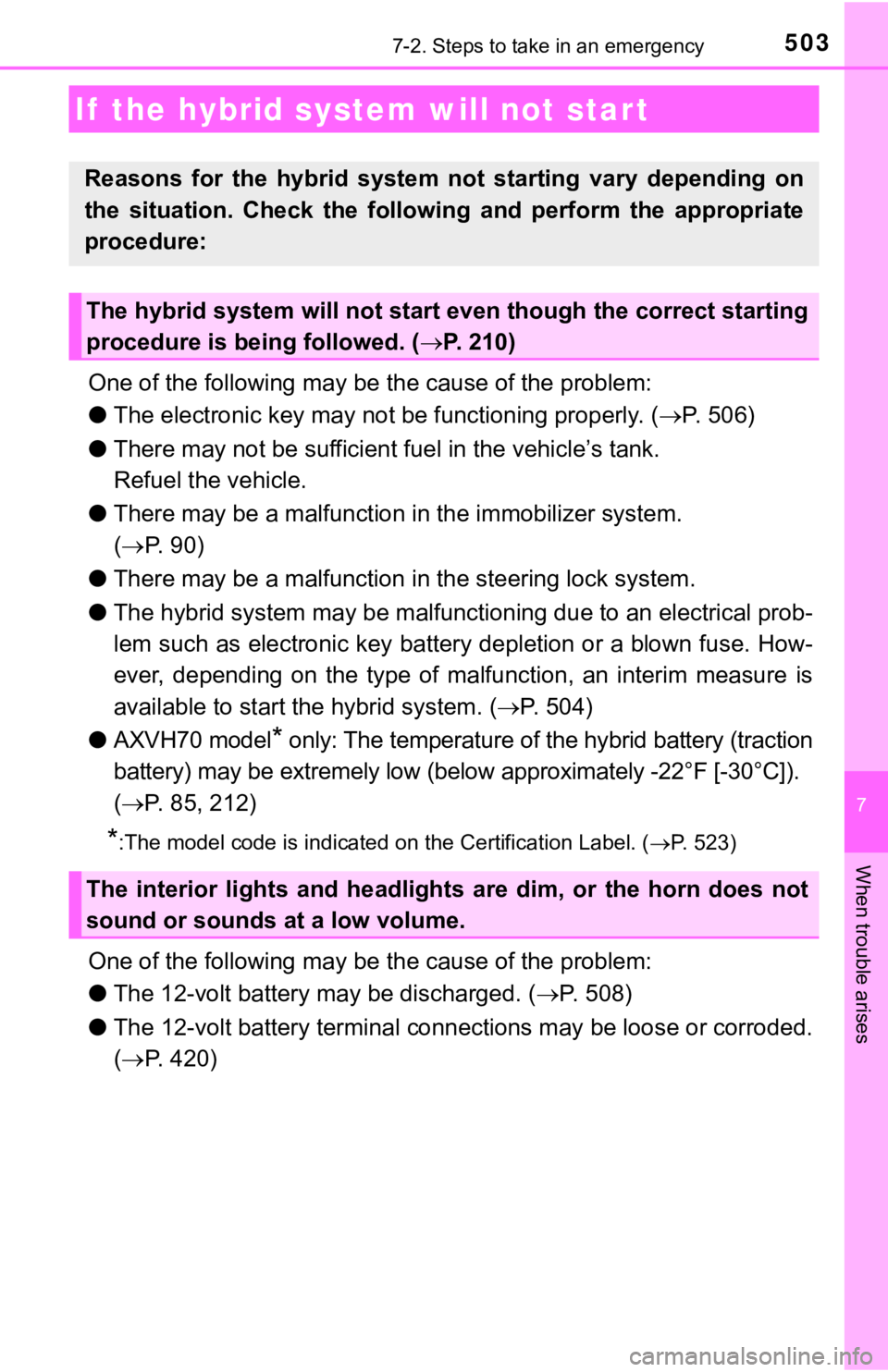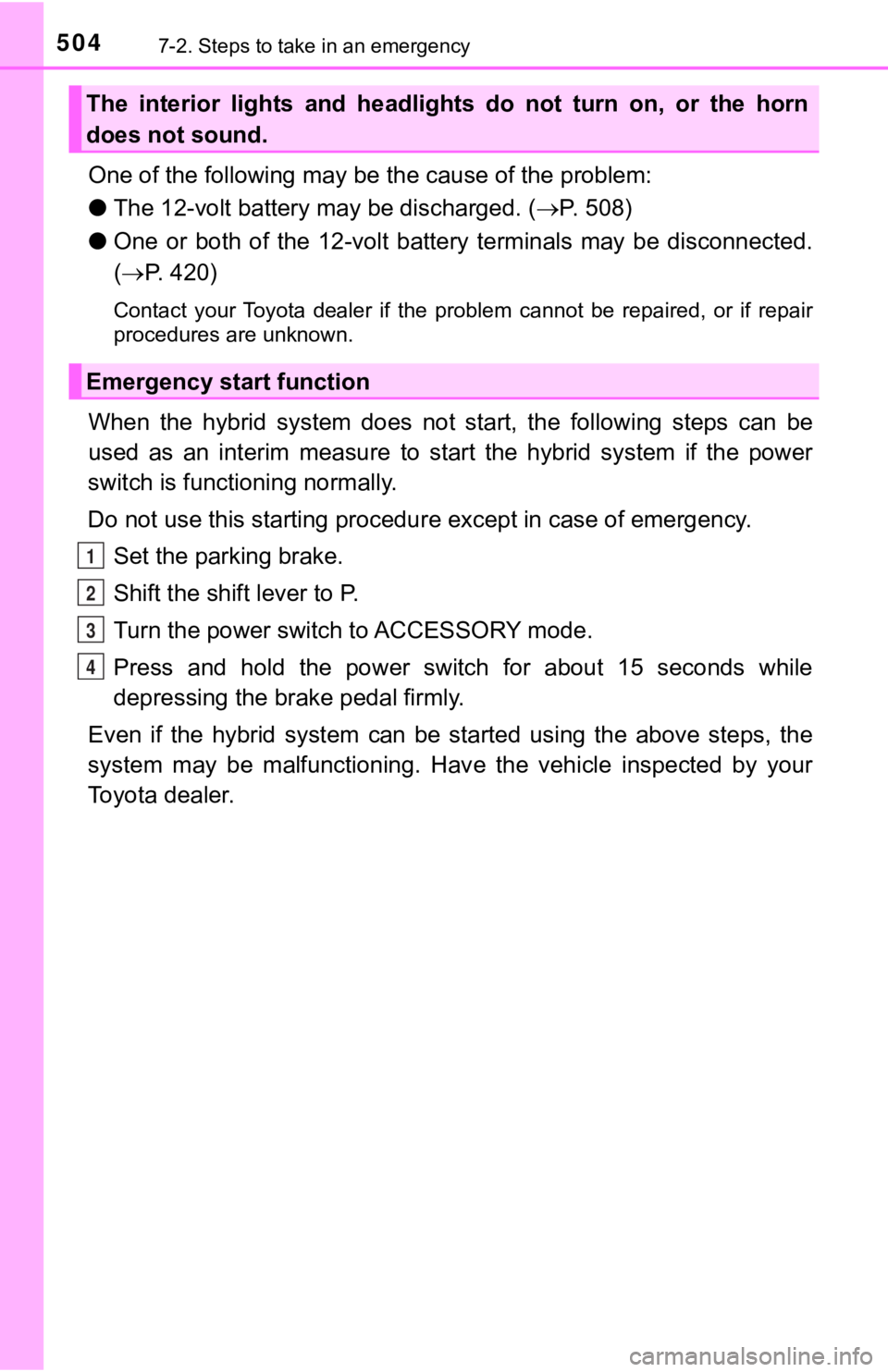2019 TOYOTA CAMRY HYBRID light
[x] Cancel search: lightPage 497 of 592

4977-2. Steps to take in an emergency
7
When trouble arises
Turn the tire jack portion “A” by
hand until the notch of the jack
is in contact with the jack point.
To prevent damage to the vehicle
when using the jack, position the
jack in the correct location.
( P. 493)
The jack point guides are located
under the rocker panel. They
indicate the jack point positions.
Assemble the jack handle.
Raise the vehicle until the tire is
slightly raised off the ground.
Remove all the wheel nuts and
the tire.
When resting the tire on the
ground, place the tire so that the
wheel design faces up to avoid
scratching the wheel surface.
4
5
6
7
Page 500 of 592

5007-2. Steps to take in an emergency
Firmly tighten each wheel nut
two or three times in the order
shown in the illustration.
Tightening torque:
76 ft•lbf (103 N•m, 10.5 kgf•m)
Stow the flat tire, tire jack and all tools.
■The compact spare tire
●The compact spare tire is identified by the label “TEMPORARY US E
ONLY” on the tire sidewall.
Use the compact spar e tire temporarily, and only in an emergenc y.
●Make sure to check the tire inflation pressure of the compact spare tire.
( P. 5 2 8 )
■When using the compact spare tire
As the compact spare tire is not equipped with a tire pressure warning
valve and transmitter, low inflation pressure of the spare tire will not be
indicated by the tire pressure warning system. Also, if you rep lace the
compact spare tire after the tire pressure warning light comes on, the light
remains on.
■When the compact spa re tire is equipped
When driving with the compact spare tire installed, the vehicle height will
be different than when driving with standard tires.
■If you have a flat front tire on a road covered with snow or ic e (vehi-
cles with 16 or 17-inch wheels)
Install the compact spare tire on one of the rear wheels of the vehicle.
Perform the following steps and f it tire chains to the front tires:
Replace a rear tire with the compact spare tire.
Replace the flat front tire with the tire removed from the rear of the vehi-
cle.
Fit tire chains to the front tires.
4
5
1
2
3
Page 501 of 592

5017-2. Steps to take in an emergency
7
When trouble arises
WARNING
■When using the compact spare tire
●Remember that the compact spare tire provided is specifically
designed for use with your vehicle. Do not use your compact spare tire
on another vehicle.
●Do not use more than one compact spare tires simultaneously.
●Replace the compact spare tire with a standard tire as soon as possi-
ble.
●Avoid sudden acceleration, abrupt steering, sudden braking and shift-
ing operations that cause sudden engine braking.
■When the compact spa re tire is attached
The vehicle speed may not be co rrectly detected, and the following sys-
tems may not operate correctly:
*:If equipped
■Speed limit when using the compact spare tire
Do not drive at speeds in excess of 50 mph (80 km/h) when a com pact
spare tire is installed on the vehicle.
The compact spare tire is not designed for driving at high spee ds. Fail-
ure to observe this precaution ma y lead to an accident causing death or
serious injury.
■After using the tools and jack
Before driving, make sure all t he tools and jack are securely i n place in
their storage locatio n to reduce the possibility of personal in jury during a
collision or su dden braking.
• ABS & Brake assist
• VSC
•TRAC
• EPS
• Automatic High Beam
•AFS (Adaptive Front-lighting
System)
*
• Dynamic radar cruise control
with full-speed range
• LDA (Lane Departure Alert with steering control) • PCS (Pre-Collision System)
• Tire pressure warning system
• BSM (Blind Spot Monitor)
*
• Intuitive parking assist*
• Intelligent Clearance Sonar
(ICS)
*
• Rear view monitor system*
• Toyota parking assist monitor*
• Panoramic view monitor*
• Navigation system*
Page 503 of 592

5037-2. Steps to take in an emergency
7
When trouble arises
One of the following may be the cause of the problem:
● The electronic key may not be functioning properly. (P. 506)
● There may not be sufficient f uel in the vehicle’s tank.
Refuel the vehicle.
● There may be a mal function in the immobilizer system.
( P. 90)
● There may be a malfunction i n the steering lock system.
● The hybrid system may be malfunc tioning due to an electrical prob-
lem such as electronic key battery depletion or a blown fuse. H ow-
ever, depending on the type of malfunction, an interim measure is
available to start the hybrid system. ( P. 504)
● AXVH70 model
* only: The temperature of the hybrid battery (traction
battery) may be extremely low ( below approximately -22°F [-30°C]).
( P. 85, 212)
*:The model code is indicated on the Certification Label. ( P. 523)
One of the following may be the cause of the problem:
● The 12-volt battery may be discharged. ( P. 508)
● The 12-volt battery terminal conn ections may be loose or corroded.
( P. 420)
If the hybrid system will not start
Reasons for the hybrid system not starting vary depending on
the situation. Check the followi ng and perform the appropriate
procedure:
The hybrid system will not start even though the correct starting
procedure is being followed. ( P. 210)
The interior lights and headlights are dim, or the horn does no t
sound or sounds at a low volume.
Page 504 of 592

5047-2. Steps to take in an emergency
One of the following may be the cause of the problem:
● The 12-volt battery may be discharged. ( P. 508)
● One or both of the 12-volt battery terminals may be disconnecte d.
( P. 420)
Contact your Toyota dealer if the problem cannot be repaired, o r if repair
procedures are unknown.
When the hybrid system does not start, the following steps can be
used as an interim measure to sta rt the hybrid system if the power
switch is functioning normally.
Do not use this starting procedure except in case of emergency.
Set the parking brake.
Shift the shift lever to P.
Turn the power switch to ACCESSORY mode.
Press and hold the power switch for about 15 seconds while
depressing the brake pedal firmly.
Even if the hybrid system can be started using the above steps, the
system may be malfunctioning. Hav e the vehicle inspected by your
Toyota dealer.
The interior lights and headlights do not turn on, or the horn
does not sound.
Emergency start function
1
2
3
4
Page 510 of 592

5107-2. Steps to take in an emergency
Start the engine of the second vehicle. Increase the engine speed
slightly and maintain at that lev el for approximately 5 minutes to
recharge the 12-volt battery of your vehicle.
Open and close any of the doors of your vehicle with the power
switch off.
Maintain the engine speed of the second vehicle and turn the po wer
switch to ON mode, then st art the vehicle's engine.
Make sure the “READY” indicator comes on. If the indicator does
not come on, contact your Toyota dealer.
Once the hybrid system has started, remove the jumper cables in
the exact reverse order from which they were connected.
Close the exclusive jump starting terminal cover, and reinstall the
fuse box cover to it s original position.
Once the hybrid system starts, have the vehicle inspected at yo ur
Toyota dealer as soon as possible.5
6
7
8
9
10
Page 511 of 592

5117-2. Steps to take in an emergency
7
When trouble arises
■Starting the hybrid system when the 12-volt battery is discharg ed
The hybrid system cannot be started by push-starting.
■ To prevent 12-volt battery discharge
●Turn off the headlights and the audio system while the hybrid s ystem is off.
● Turn off any unnecessary electrical components when the vehicle is running
at a low speed for an extended period, such as in heavy traffic .
■ When the 12-volt battery is removed or discharged
● Information stored in the ECU is cleared. When the 12-volt batt ery is
depleted, have the vehicle inspected at your Toyota dealer.
● Some systems may require initialization. ( P. 555)
■ When removing the 12-vo lt battery terminals
When the 12-volt battery terminals are removed, the information stored in the
ECU is cleared. Before removing the 12-volt battery terminals, contact your
Toyota dealer.
■ Charging the 12-volt battery
The electricity stored in the 12-volt battery will discharge gr adually even when
the vehicle is not in use, due to natural discharge and the dra ining effects of
certain electrical appliances. If the vehicle is left for a lon g time, the 12-volt
battery may discharge, and the hybrid system may be unable to start. (The
12-volt battery recharges automatically while the hybrid system is operating.)
■ When recharging or replacing the 12-volt battery
●In some cases, it may not be possible to unlock the doors using the smart
key system when the 12-volt battery is discharged. Use the wire less remote
control or the mechanical key to lock or unlock the doors.
● The hybrid system may not start on the first attempt after the 12-volt battery
has recharged but will start normally after the second attempt. This is not a
malfunction.
● The power switch mode is memorized by the vehicle. When the 12- volt bat-
tery is reconnected, the system will return to the mode it was in before the
12-volt battery was discharged. Before disconnecting the 12-volt battery,
turn the power switch off.
If you are unsure what mode the power switch was in before the 12-volt bat-
tery discharged, be especially careful when reconnecting the 12 -volt battery.
Page 513 of 592

5137-2. Steps to take in an emergency
7
When trouble arises
WARNING
■When removing the 12-vo lt battery terminals
Always remove the negative (-) terminal first. If the positive (+) terminal con-
tacts any metal in the surrounding area when the positive (+) terminal is
removed, a spark may occur, leading to a fire in addition to el ectrical shocks
and death or serious injury.
■ Avoiding 12-volt batte ry fires or explosions
Observe the following precautions to prevent accidentally ignit ing the flam-
mable gas that may be emitted from the 12-volt battery:
● Make sure each jumper cable is connected to the correct terminal and that
it is not unintentionally in contact with any other than the in tended terminal.
● Do not allow the other end of the jumper cable connected to the “+” termi-
nal to come into contact with any other parts or metal surfaces in the area,
such as brackets or unpainted metal.
● Do not allow the + and - clamps of the jumper cables to come into contact
with each other.
● Do not smoke, use matches, cigarette lighters or allow open fla me near
the 12-volt battery.
■ 12-volt battery precautions
The 12-volt battery contains poisonous and corrosive acidic ele ctrolyte,
while related parts contain lead and lead compounds. Observe th e following
precautions when handling the 12-volt battery:
● When working with the 12-volt battery, always wear safety glass es and
take care not to allow any battery fluids (acid) to come into c ontact with
skin, clothing or the vehicle body.
● Do not lean over the 12-volt battery.
● In the event that battery fluid comes into contact with the skin or eyes,
immediately wash the affected area with water and seek medical attention.
Place a wet sponge or cloth over the affected area until medica l attention
can be received.
● Always wash your hands after handling the 12-volt battery support, termi-
nals, and other 12-volt battery-related parts.
● Do not allow children near the 12-volt battery.
■ After recharging the 12-volt battery
Have the 12-volt battery inspected at your Toyota dealer as soon as possi-
ble.
If the 12-volt battery is deteriorating, continued use may caus e the 12-volt
battery to emit a malodorous gas, which may be detrimental to the health of
passengers.